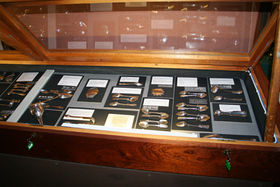Email: info@grahamkey.co.uk
Mob: 07833-660976
Conservation of a Silverware Collection
Dumfries & Galloway Council
History:
Dumfries Museum has an excellent collection of local silver, some of which was already on display and some of which was held in reserve collections. Funding had been obtained to expand and refresh the museums display.
These include an early 19th century cream jug made by Dumfries silversmith Joseph Pearson and a Silver gun medal that was presented to Hammerman (blacksmith) James Johnston in 1828.
The earliest reference to a silver trade in Dumfries occurs in 1504 when King James IV paid “the Dumfries goldsmith” 14 shillings for falconry equipment. Between 1500 and 1900 there were over 30 silversmiths living and working in Dumfries. Few could rely on sufficient business to make only silverware, and most of them also worked at other trades such as gunsmithing or clockmaking. Their output was mainly flatware or cutlery and other tableware. But they also made medals, communion cups and snuff mulls.
Some Scottish towns, including Dumfries, had their own marks for silverware. The main town marks used by Dumfries silversmiths were an anchor, a unicorn’s head and a stag’s head.
Work Required:
The current desktop display case had proved to be too small for the expanding Dumfries silverware collection.
The current case had poor security, being of bespoke timber construction with simple mortice locks and 4mm plain glass.
Many of the materials used in the cases construction were not inert, so the opportunity for these to 'off gas' and emit pollutants that may damage the objects was fairly high.
Equally, the environment for the objects was not ideal, as the case was not sealed and the air exchange unknown. This problem created a environment inside the case that was difficult to control.
All objects were dull and tarnished and displayed polish residue from previous cleaning.
Some of the objects were poorly mounted and displayed and new mounts were required.
The case was a bespoke made item and had poor security compared to modern purpose built items. this include inadequate construction of carcass, locks and glass.
Many of the materials used were not inert and could easily 'off gas' creating pollutants present within the micro-climate of the case and so accelerate tarnishing and corrosion of the objects.
Equally, the case was not well sealed and had an unknown air exchange of this micro-climate exacerbating the problem.
The case was poorly lit from external spotlights.
A larger case with more space was required to display parts of the reserve collection along with the original items.
Work Carried Out:
A new display case was purchased by the museum that fitted the space and had adequate capacity for the bulk of the bulk of the silverware collection. The new case conformed to the various British Standards necessary. The new case featured inert materials used throughout featuring powder coated steel frame, silicone gaskets, formaldehyde free, sealed carcass panels and glass shelves etc.
In addition bandit proof toughened, laminated glass, high quality Abloy locks and low temperature controllable LED lights were also employed.
All objects were removed from the case and their condition assessed.
Conservation treatments were used to clean tarnish and other contaminants from the objects. A 'minimal intervention' approach was used here with chemical cleaning being preferred here where possible, as apposed to mild abrasive polishes. A protective wax coating was also applied prior to being re-displayed.
All objects had written and photographic conservation treatment records created using the museums collections database.
The objects were re-mounted on high quality Acrylic mounts where required.
Appropriate light levels were set inside the case and conditioned silica gel cassettes were employed throughout the interior of the case. This acted as a buffer to obtain correct relative humidity levels inside the case.



















